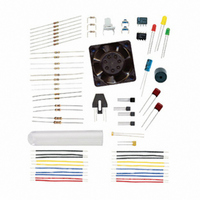130-28176 Parallax Inc, 130-28176 Datasheet - Page 307

130-28176
Manufacturer Part Number
130-28176
Description
KIT PARTS PROCESS CONTROL
Manufacturer
Parallax Inc
Specifications of 130-28176
Accessory Type
Education Kit
Product
Microcontroller Accessories
Lead Free Status / RoHS Status
Contains lead / RoHS non-compliant
For Use With/related Products
Board of Education Full Kit
Lead Free Status / RoHS Status
Lead free / RoHS Compliant, Contains lead / RoHS non-compliant
- Current page: 307 of 330
- Download datasheet (11Mb)
Final Challenge: Incubator Tuning
Tuning a PID system involves adjusting the software parameters for each factor. The goal
of tuning the system is to adjust the gains so the loop will have optimal performance
under dynamic conditions. As mentioned earlier, tuning is as much of an art as it is a
science. The basic procedures for tuning a PID controller are as follows. This procedure
assumes you can provide or simulate a quickstep change in the error signal:
As you gain experience in embedded control, you will see that the characteristics of the
process will determine how you should react to error.
Part A:
Part B:
A new species of eggs have arrived!
1. Turn all gains to 0.
2. Begin turning up the proportional gain until the system begins to oscillate.
3. Reduce the proportional gain until the oscillations stop, and then drop it by about
4. Increase the derivative term to improve response time and system stability.
5. Increase the integral term until the system reaches the point of instability, and
√
√
√
√
√
√
20 % more.
then back it off slightly.
Load and run IncubatorPID-SP.bs2.
Use StampPlot macro sic_pc_pid_sp_calc.spm.
Tune the PID settings for the fastest stabilization for the incubator temperature of
101.5 °F +/− 1 °F with a bias of 50% and drive time of 2 seconds. Start from a
stable temperature at the setpoint, and provide standard disturbance.
Discuss your results and capture a screenshot of control action.
Re-tune your system to control the temperature at 110 °F, +/− 2 °F with a 50%
bias and drive time of 1 second. Start from a stable temperature at the setpoint,
and provide standard disturbance.
Discuss your results and capture a screenshot of control action following a
disturbance.
Related parts for 130-28176
Image
Part Number
Description
Manufacturer
Datasheet
Request
R

Part Number:
Description:
KIT PROPELLER EDU PROJECT PARTS
Manufacturer:
Parallax Inc
Datasheet:

Part Number:
Description:
KIT PARTS SMART SENSORS
Manufacturer:
Parallax Inc
Datasheet:

Part Number:
Description:
Microcontroller Modules & Accessories DISCONTINUED BY PARALLAX
Manufacturer:
Parallax Inc

Part Number:
Description:
BOOK UNDERSTANDING SIGNALS
Manufacturer:
Parallax Inc
Datasheet:

Part Number:
Description:
COMPETITION RING FOR SUMOBOT
Manufacturer:
Parallax Inc
Datasheet:

Part Number:
Description:
TEXT INFRARED REMOTE FOR BOE-BOT
Manufacturer:
Parallax Inc
Datasheet:

Part Number:
Description:
Microcontroller Modules & Accessories DISCONTINUED BY PARALLAX
Manufacturer:
Parallax Inc

Part Number:
Description:
BOOK UNDERSTANDING SIGNALS
Manufacturer:
Parallax Inc
Datasheet:

Part Number:
Description:
BOARD EXPERIMENT+LCD NX-1000
Manufacturer:
Parallax Inc
Datasheet:

Part Number:
Description:
IC MCU 2K FLASH 50MHZ SO-18
Manufacturer:
Parallax Inc
Datasheet:













